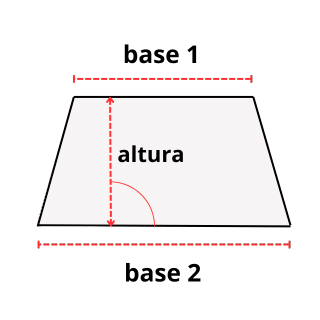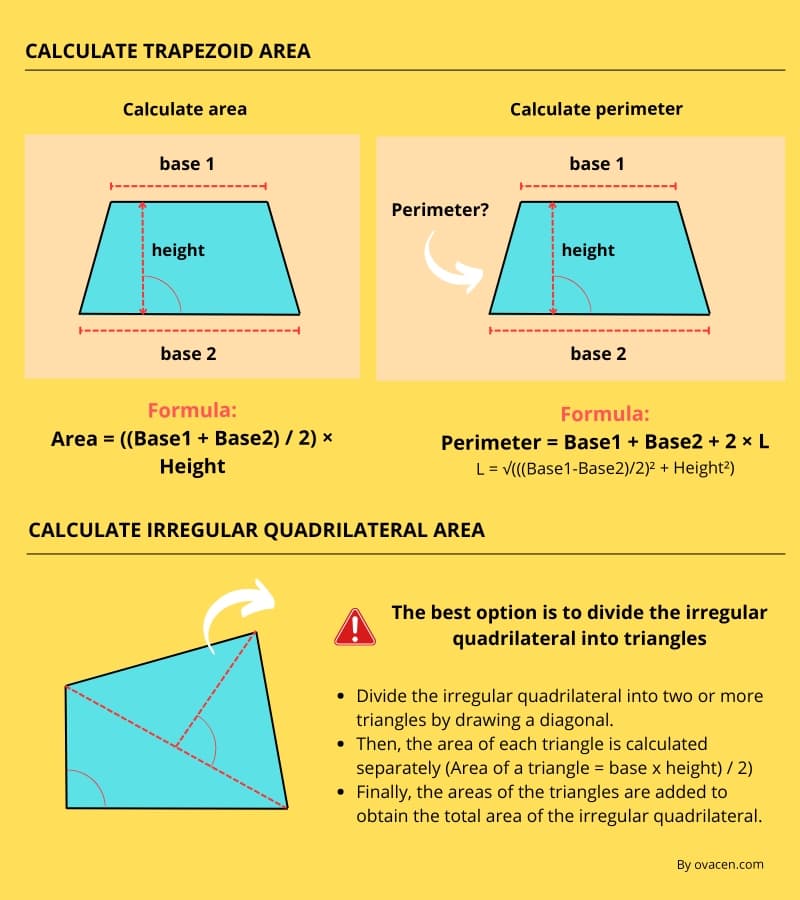Calculate instantly online! Your math assistant to calculate the area of a trapezoid (trapezium area) easily and quickly.
Trapezoid area calculator

Area:
0.00
A = ((Base1 + Base2) / 2) × Height
Perimeter:
0.00
P = Base1 + Base2 + 2 × L
L = √(((Base1-Base2)/2)² + Height²)
Do you want to see other calculation tools?
The following online calculation application is a tool to calculate the area of a trapezoid, based on the lengths of its bases and its height. Calculate the extension of the trapezoid using the formula Trapezoid area = ((Smaller base + Larger base) × Height) / 2, it can be used for both small and large elements.
Additionally, optionally, it allows calculating the surface of the trapezoid also knowing the perimeter.
How does the trapezoid area calculator work?
The process to use the trapezoid area calculator is simple and fast:
- Enter data:
- You must enter the values of the smaller base, the larger base, and the height (h) in the corresponding fields.
- Area calculation:
- The calculator applies the formula for the area of a trapezoid: A = ((Base1 + Base2) / 2) × Height
- Once the values are entered, the area is automatically displayed.
- Additional calculation options:
- Alternatively, the trapezoidal surface can be calculated using the perimeter, which will replace one of the base elements or the height.
- If we use the perimeter to calculate, the formula is: Trapezoid perimeter = Base1 + Base2 + 2 × L, where L = √(((Base1-Base2)/2)² + Height²).
Remember! The basic trapezoid formula, Area = ((Larger base + Smaller base) × Height) / 2, is the most used and practical when the bases and height are known.
You can calculate the trapezoidal area as long as the input values are positive. The application facilitates the calculation of the area of a trapezoid in a simple way and also provides additional methods according to the information available to the user.
How to calculate the area of a trapezoid?
We remind you that the formula to calculate the area of a trapezoid is: Area = ((Larger base + Smaller base) × Height) / 2. To clarify the calculations, we leave the following image:

How to find a trapezoid area:
- Find the length of each base (length of smaller base and larger base).
- Find the height of the trapezoid (h).
- Substitute the values into the formula Area = (a + b) × h / 2.
Example, if you have a trapezoid with a larger base of 12 cm, a smaller base of 8 cm, and a height of 5 cm. To find what it occupies, simply add the bases, multiply by the height, and divide the result by two. The calculation would be: Trapezoid surface = ((12 + 8) × 5) / 2 = 50.
However, if we do not know the bases and the height, there are other options. The mathematical formulas to know the surface occupied by a trapezoid are:
- Calculate the area of the trapezoid knowing the diagonals and the angle between them, you can use the formula Area = (Diagonal 1 × Diagonal 2 × sin(θ)) / 2, where “sin” is the sine of the angle (θ).
- Calculate irregular quadrilateral area, in this case, it is best to divide the space it occupies into different triangles and then add each surface (Area of a triangle = base x height) / 2).
Related to the subject, if you don’t know any side in a right triangle, a Pythagorean Theorem calculator can easily provide the distance of a leg or the hypotenuse.
🟧 Note: If you have any questions about this online calculator for trapezoidal prism surface area, do not hesitate to contact us from the contact section at the footer.
Frequently asked questions about the area of a trapezoid – FAQ
What is a trapezoid?
A trapezoid is a quadrilateral that has at least one pair of opposite sides parallel. The parallel sides are called bases (larger base and smaller base), and the perpendicular distance between them is called height.
Is a trapezoid the same as a trapezoid?
No, “trapezoid” refers to a quadrilateral with one pair of parallel sides, while “trapezoid” is used to describe a quadrilateral without parallel sides.
What is the formula to calculate the area of a trapezoid?
The formula to obtain the area of a trapezoid is: Area = ((Smaller base + Larger base) × Height) / 2
How to find a trapezoid area?
First, find the length of each base (length of smaller base and larger base). In second place, find the height of the trapezoid (h) and substitute the values into the formula Area = (a + b) × h / 2.
Can the area of a trapezoid be calculated without knowing the bases?
No, it is impossible to calculate the area of a trapezoid without knowing at least one base length. The bases are fundamental to applying the area formula. If you do not have this information, you will need additional data, such as the perimeter or angles, to solve the problem.
What is the difference between calculating the area of a trapezoid and that of a parallelogram?
The parallelogram has the formula to obtain the area: Base × Height. In the case of the trapezoid, Area = ((Smaller base + Larger base) × Height) / 2 is used because the two bases are not equal.
What do I do if the trapezoid is isosceles?
In an isosceles trapezoid, the non-parallel sides are equal. You can divide the isosceles trapezoid into a rectangle in the center and two identical right triangles on the sides. Then add surfaces.
How is a trapezoid divided into triangles to calculate its area?
To divide a trapezoid into triangles, draw a diagonal from one of the vertices of the larger base to the opposite vertex of the smaller base. This will divide the trapezoid into two triangles. Then, you can calculate the area of each triangle using the formula: (base × height) / 2
